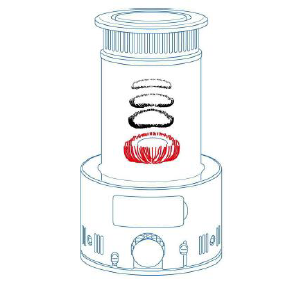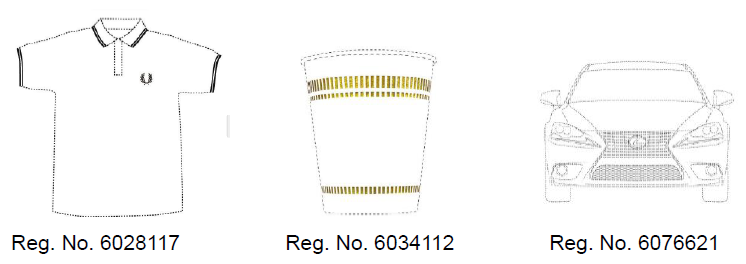June 30, 2020
Trademark News
The IP High Court denied distinctiveness of a position trademark consisting of a three-dimensional shape of flames mirrored in the combustion cylinder of an oil stove.
The applicant (TOYOTOMI CO., LTD., the "Plaintiff") of a position trademark consisting of a three-dimensional shape of flames mirrored in the combustion cylinder of an oil stove (the "Shape of Flames") appealed to the Intellectual Property High Court (the "IP High Court") against a decision by the Japan Patent Office (the "JPO") that denied distinctiveness of a trademark finding that the Shape of Flames was intended for contribution to enhance the function or appearance of the products and had not acquired distinctiveness through use of the mark. The IP High Court also rejected the Plaintiff's claim (IP High Court No. 2019 (gyo-ke) 10125, judgement issued on February 12, 2020).
1. Background
The Plaintiff's trademark application is as follows.
[Plaintiff's Application]
App. No. 2016-9831
Designated goods: Oil stoves [space heaters for household use] (Class 11)
Mark (position mark):

[Plaintiff's Products]

As a result of the examination, the application was rejected and during the trial against the examiner's decision of refusal, the Plaintiff made amendments to the designated goods from "Oil stoves [space heaters for household use]" to "Convection oil stoves [space heaters for household use]" and the detailed description of the mark, which says in summary that the applied mark is a position mark consisting of a three-dimensional shape of three ring-like flames (described in black in the above figure) mirrored in the combustion cylinder of an oil stove when combustion occurrs in the stove and the other parts described in blue and red are not elements constituting the trademark.
The JPO trial board decided to reject the Plaintiff's claim finding that the Shape of Flames was intended for contribution to enhance the function or appearance of the stove (Article 3(1)(iii) of the Trademark Act). Further, the JPO trial board did not acknowledge acquired distinctiveness through use of the mark finding that the Shape of Flames was not particularly noticeable and thus not likely to be recognized as an indication of origin of the goods (Article 3(2) of the Trademark Act).
2. Court Judgement
The IP High Court ruled that shapes of the goods are mostly intended to enhance the function or appearance of the goods and basically recognized as trademarks consisting only of a mark used in a common manner, which lack distinctiveness and are denied registration (Article 3(1)(iii) of the Trademark Act).
The Plaintiff had a patent right on the stove including the mirrored image of flames similar to the applied mark, which have expired in 2000 (Patent Reg. No. 1508319), and its specification says that the image of flames improves the heating effect and produces the design effect. In view of this description, as well as the enhanced appearance of the stove by the Shape of Flames, the IP High Court acknowledged the Shape of Flames as that for enhancing the function or appearance of the stove and concluded that the Shape of Flames is a trademark consisting only of a mark used in a common manner.
Secondly, the IP High Court ruled that it is judged in consideration of the shape itself, duration of use, territory of use, sales amount, duration and scale of advertisements and existence of other goods that have similar shape whether or not a position trademark consisting of a three-dimensional shape has acquired distinctiveness through use (Article 3(2) of the Trademark Act).
The Plaintiff's oil stoves have been sold since 1980 and other brand's oil stoves do not have the shape identical with or similar to the Shape of Flames. The share of the Plaintiff's oil stove since 2011 was about 22.5 % among convection oil stoves (while it was only about 2% among convection oil stoves and reflective oil stoves). The Shape of Flames is unique. the Plaintiff's oil stove won the Good Design Award and has been featured in the media. The Plaintiff claimed that the Shape of Flames had acquired distinctiveness through its long use mentioning the above achievements of the Plaintiff's oil stove.
The IP High Court, however, found that considering that the Shape of Flames did not appear when the stove was not in use, consumers were unlikely to recognize the Shape of Flames in most scenes and because the Shape of Flames was intended for enhancement of the function or appearance, consumers were unlikely to see the Shape of Flame as an indication of the Plaintiff's oil stove regardless of the above points raised by the Plaintiff. The IP High Court rejected the Plaintiff's claim on acquired distinctiveness.
3. Comments
Since position trademarks were introduced along with other new types of trademarks (sounds, colors per se, motions and holograms) into Japan after the 2014 amendment to the Trademark Act, position marks including the following have been registered.

Compared with these marks, the Plaintiff's mark is different in that the mark appears only when the stove is in use. This means that the mark is less likely to be easily recognized by consumers in stores and may lead to a conclusion that the mark is not considered as an indication of origin of the goods. In order for such a mark to get registered, the advertising strategy from the viewpoint of how to appeal the products to consumers especially focusing on the mark itself will be particularly important.
Written by: Ms. Tomoko Honami (Attorney at Law)